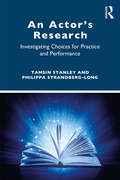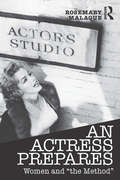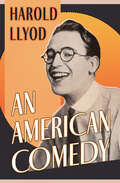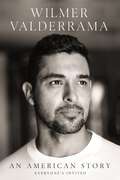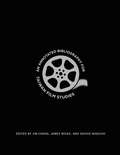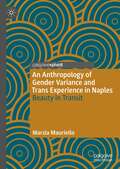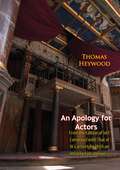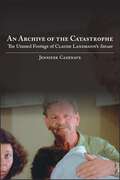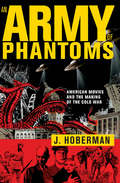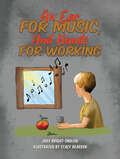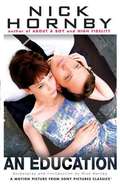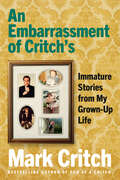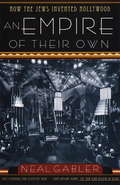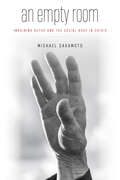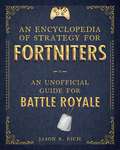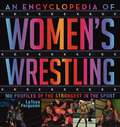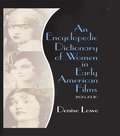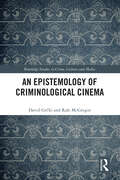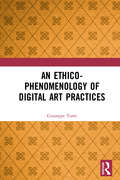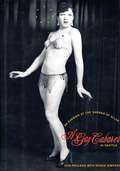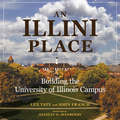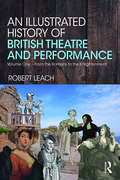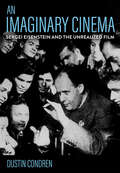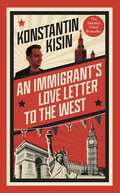- Table View
- List View
An Actor’s Research: Investigating Choices for Practice and Performance
by Tamsin Stanley Philippa Strandberg-LongAn Actor’s Research: Investigating Choices for Practice and Performance presents an accessible and highly practical guide to the research approaches required of the actor. It aims to establish the precision and rigour of the actor’s craft that is intrinsic to a compelling acting performance, explore a range of research activities surrounding and emerging from practical work in the studio, and enable the actor to evolve a multifaceted skillset in researching for performance. The chapters focus on different research areas such as the self, character, relationships, circumstance, and context, providing accessible and practical guidance to developing a personal research practice. Each aspect is explained and engaged with as practice, rather than study – offering helpful hints and advising against common pitfalls – ultimately enabling the actor to locate the necessary knowledge to shape and inform their performance in both text-based and devised scenarios. Additionally, as the actor’s self is a personal instrument that is drawn on in terms of expression, impulses, and imagination; the self also becomes a source for creative appraisal and research. This book therefore offers comprehensive advice and strategies for self-evaluation and reflection, connecting research investigation with self-exploration in making expressive performance choices, making it a practice highly applicable to the actor’s needs. An Actor’s Research closely follows the training actor’s needs in terms of performance-based research; however, its practical research activities for text and character creation and strategies for the development of critical thinking and self-reflective skills support the ongoing development of the actor and their craft in both training and professional circumstances.
An Actress Prepares: Women and "the Method"
by Rosemary Malague'Every day, thousands of women enter acting classes where most of them will receive some variation on the Stanislavsky-based training that has now been taught in the U.S. for nearly ninety years. Yet relatively little feminist consideration has been given to the experience of the student actress: What happens to women in Method actor training?' An Actress Prepares is the first book to interrogate Method acting from a specifically feminist perspective. Rose Malague addresses "the Method" not only with much-needed critical distance, but also the crucial insider's view of a trained actor. Case studies examine the preeminent American teachers who popularized and transformed elements of Stanislavsky’s System within the U.S.—Strasberg, Adler, Meisner, and Hagen— by analyzing and comparing their related but distinctly different approaches. This book confronts the sexism that still exists in actor training and exposes the gender biases embedded within the Method itself. Its in-depth examination of these Stanislavskian techniques seeks to reclaim Method acting from its patriarchal practices and to empower women who act. 'I've been waiting for someone to write this book for years: a thorough-going analysis and reconsideration of American approaches to Stanislavsky from a feminist perspective ... lively, intelligent, and engaging.' – Phillip Zarrilli, University of Exeter 'Theatre people of any gender will be transformed by Rose Malague’s eye-opening study An Actress Prepares... This book will be useful to all scholars and practitioners determined to make gender equity central to how they hone their craft and their thinking.' – Jill Dolan, Princeton University
An American Comedy
by Harold Lloyd Wesley W. StoutThis autobiography by an influential silent film star gives an insider&’s view of the motion picture industry in the early twentieth century. It&’s one of the most enduring images in film history: a young man in circular glasses, dangling from the hands of a clock high above Los Angeles. The actor performing this daring stunt was Harold Lloyd, a highly successful comedian from the silent film era. Lloyd made nearly two hundred comedies, both silent and &“talkies,&” between 1914 and 1947. He is best known for his &“Glass&” character, a bespectacled everyman who captured the mood of the 1920s. In this fascinating autobiography, which was written just around the time sound was revolutionizing cinema, Lloyd chronicles his experiences as a performer and producer of silent films, preserving firsthand details of Hollywood&’s bygone period. This extraordinary memoir, originally published in 1928, discusses actors both comedic and dramatic, stage to film adaptations, producers, directors, and primarily, how early silent movies were made. It is a must-read for film historians and movie buffs alike.
An American Story: Everyone’s Invited
by Wilmer ValderramaThe remarkable true story of a young immigrant from Venezuela who had a dream to change the world, a talent for entertaining, and a determined spirit to build a new life, taking as many as possible with him on the journey.An American Story is the stirring memoir by actor, producer, and activist Wilmer Valderrama, delving into his upbringing in Venezuela where he was raised by two hard working parents as they navigated their family through a rapidly changing country and the rise of Hugo Chavez. With the economy crashing around them and their livelihood disappearing, the family decides to flee the country. Suddenly, the young boy who had loved riding his horse and dreaming of being Zorro from his favorite black and white tv show had to grow up quickly, journeying as a teenager from a tiny little pueblo in Venezuela to the big city of Los Angeles.After being cast in a school theatre production, Valderrama knew he had found his calling, and began thinking of ways to help support his struggling family. He would attempt the impossible: find work in Hollywood as an unproven Latino actor. Following countless auditions and frequent criticisms of his accent, he created the personality that would eventually land him the role as Fez on the hit series That 70s Show, which catapulted him to stardom.Over the coming years, he would create the smash show, Yo Mamma, voice the lead character in Disney&’s Encanto, and so much more, culminating in his joining the cast of the hit show NCIS in 2016.It was through service to others and his first USO trip, however, where Valderrama found his expanded calling, entertaining and encouraging U.S. troops around the world. He has since traveled with the USO a multitude of times, having participated in almost 50 tours domestically and internationally and was recently named USO Global Ambassador.Through his work, Valderrama hopes to demonstrate his love and gratitude for the country that changed his life. An American Story weaves Valderrama&’s personal stories with those of the remarkable people he&’s met along his philanthropic journey. This isn&’t just Valderrama&’s story, though. It&’s a view of America through an immigrant&’s eyes, in both its stunning unmatched wonders and all its native challenges. It is the profound and gripping story of someone who found the way and is now inviting as many as possible to join him on the adventure.
An Annotated Bibliography for Taiwan Film Studies
by James Jim Cheng Wicks Noguchi SachieCompiled by two skilled librarians and a Taiwanese film and culture specialist, this volume is the first multilingual and most comprehensive bibliography of Taiwanese film scholarship, designed to satisfy the broad interests of the modern researcher. The second book in a remarkable three-volume research project, An Annotated Bibliography for Taiwan Film Studies catalogues the published and unpublished monographs, theses, manuscripts, and conference proceedings of Taiwanese film scholars from the 1950s to 2013. Paired with An Annotated Bibliography for Chinese Film Studies (2004), which accounts for texts dating back to the 1920s, this series brings together like no other reference the disparate voices of Chinese film scholarship, charting its unique intellectual arc. <P><P>Organized intuitively, the volume begins with reference materials (bibliographies, cinematographies, directories, indexes, dictionaries, and handbooks) and then moves through film history (the colonial period, Taiwan dialect film, new Taiwan cinema, the 2/28 incident); film genres (animated, anticommunist, documentary, ethnographic, martial arts, teen); film reviews; film theory and technique; interdisciplinary studies (Taiwan and mainland China, Taiwan and Japan, film and aboriginal peoples, film and literature, film and nationality); biographical materials; film stories, screenplays, and scripts; film technology; and miscellaneous aspects of Taiwanese film scholarship (artifacts, acts of censorship, copyright law, distribution channels, film festivals, and industry practice). Works written in multiple languages include transliteration/romanized and original script entries, which follow universal AACR-2 and American cataloguing standards, and professional notations by the editors to aid in the use of sources.
An Anthropology of Gender Variance and Trans Experience in Naples: Beauty in Transit
by Marzia MaurielloThis book recounts the author’s fieldwork among the trans and gender-variant communities in Naples. This is where a gender-variant figure, the femminiello, has found a safe environment within the city’s historical poorest neighborhoods, the so-called “quartieri popolari”, which were and continue to be culturally and socially connoted. The femminielli, who can be read as “suspended” figures between the feminine and the masculine, provide the background for a discourse on the meanings that genders and sexualities have assumed in modern Naples. This is done with significant openings to theoretical reasoning that is both extraterritorial and multidisciplinary. Starting from the micro context, the aim of the book is to explore the breadth and complexity of the gender variant and trans experience, with particular reference to the changing meanings of the body, which are also tied to the collective images of beauty in contemporary times.
An Apology for Actors: From the Edition of 1612, Compared with That of W. Cartwright. With an introduction and notes
by Thomas HeywoodHeywood is a good example of the professional dramatist who worked for Philip Henslowe, the theatrical manager, both as a playwright and an actor. By his own admission, Heywood claimed to have "either an entire hand or at least the main finger" in 220 plays, of which less than 30 survive. His best-known play, A Woman Killed with Kindness (1603), exemplifies domestic tragedy, in which sentiment and homely details are equally mingled. Heywood wrote an eloquent defense of the theater against Puritan attack called An Apology for Actors (1607-08). Heywood suggests here that the stage can both delight and teach.-Print ed.
An Archive of the Catastrophe: The Unused Footage of Claude Lanzmann's Shoah (SUNY series in Contemporary Jewish Literature and Culture)
by Jennifer CazenaveHonorable Mention, 2020 Best First Book Award presented by the Society for Cinema and Media StudiesClaude Lanzmann's 1985 magnum opus, Shoah, is a canonical documentary on the Holocaust—and in film history. Over the course of twelve years, Lanzmann gathered 230 hours of location filming and interviews with survivors, witnesses, and perpetrators, which he condensed into a 9½-hour film. The unused footage was scattered and inaccessible for years before it was restored and digitized by the United States Holocaust Memorial Museum. In An Archive of the Catastrophe, Jennifer Cazenave presents the first comprehensive study of this collection. She argues that the outtakes pose a major challenge to the representational and theoretical paradigms produced by the documentary, while offering new meanings of Shoah and of Holocaust testimony writ large. They lend fresh insight into issues raised by the film, including questions of resistance, rescue, refugees, and, above all, gender—Lanzmann's twenty hours of interviews with women make up a mere ten minutes of the finished documentary. As a rare instance of outtakes preserved during the predigital era of cinema, this unused footage challenges us to establish a new critical framework for understanding how documentaries are constructed and reshapes the way we view this key Holocaust film.To view the book trailer on YouTube, please go to: https://www.youtube.com/watch?v=bBjUWyAn55g
An Army of Phantoms: American Movies and the Making of the Cold War
by J. HobermanThe film critic&’s sweeping analysis of American cinema in the Cold War era is both &“utterly compulsive reading [and] majestic&” in its &“breadth and rigor&” (Film Comment). An Army of Phantoms is a major work of film history and cultural criticism by leading film critic J. Hoberman. Tracing the dynamic interplay between politics and popular culture, Hoberman offers &“the most detailed year-by-year look at Hollywood during the first decade of the Cold War ever published, one that takes film analysis beyond the screen and sets it in its larger political context&” (Los Angeles Review of Books). By &“tell[ing] the story not just of what&’s on the screen but of what played out behind it,&” Hoberman demonstrates how the nation&’s deep-seated fears and wishes were projected onto the big screen. In this far-reaching work of historical synthesis, Cecil B. DeMille rubs shoulders with Douglas MacArthur, atomic tests are shown on live TV, God talks on the radio, and Joe McCarthy is bracketed with Marilyn Monroe (The American Scholar). From cavalry Westerns to apocalyptic sci-fi flicks, and biblical spectaculars; from movies to media events, congressional hearings and political campaigns, An Army of Phantoms &“remind[s] you what criticism is supposed to be: revelatory, reflective and as rapturous as the artwork itself&” (Time Out New York). &“An epic . . . alternately fevered and measured account of what might be called the primal scene of American cinema.&” —Cineaste &“There&’s something majestic about the reach of Hoberman&’s ambitions, the breadth and rigor of his research, and especially the curatorial vision brought to historical data.&” —Film Comment
An Ear for Music, And Hands for Working
by Judy Bright-EnglishJust imagine being a young boy sitting behind your desk at home, and every morning you hear music and the sound of marching feet.But you&’re too short to see over the windowsill. The music passes by, and you wonder what it would be like to play with them. Then a gift from his housekeeper and some good news from his father gives this young boy a chance.
An Education
by Nick HornbyFrom the New York Times bestselling author—the shooting script to his award-winning film, with an original Introduction and vivid stills from the movie. Jenny is a 16-year-old girl stifled by the tedium of adolescence; she can’t wait for her sophisticated adult life to begin. One rainy day her suburban existence is upended by the arrival of David, a much older suitor who introduces her to a glittering new world of concerts, art, smoky bars, urban nightlife, and his glamorous friends, replacing her traditional education with his own version. It could be her awakening—or her undoing. This edition of Hornby’s adapted screenplay, which includes stills from the film, is a perfect accompaniment to the highly anticipated movie, which stars Carey Mulligan as Jenny, Peter Sarsgaard, Emma Thompson, Dominic Cooper, and Alfred Molina. It is a must-have for fans of Hornby’s novels, featuring his signature pitch-perfect dialogue, mordant wit, and the resonant humanity of his writing. Watch a Video .
An Embarrassment of Critch's: Immature Stories From My Grown-Up Life
by Mark CritchThe heartfelt and hilarious story of beloved Canadian comedian Mark Critch's journey from Newfoundland to the national stage--and back home again. One of Mark Critch's earliest acting gigs was in a Newfoundland tourist production alongside a cast of displaced fishery workers. Since, he's found increasing opportunities to take his show on the road. In An Embarrassment of Critch's, the star of CBC's This Hour Has 22 Minutes revisits some of his career's--and the country's--biggest moments, revealing all the things you might not know happened along the way: A wishful rumour spread by Mark's father results in his big break; two bottles of Scotch nearly get him kicked out of a secret Canadian airbase in the United Arab Emirates; and for anyone wondering how to get an interview with the Prime Minister and Bono (yes, that Bono) on the same evening, Critch might recommend a journey to the 2003 Liberal Convention. Critch's top-secret access to all of the funniest behind-the-scenes moments involve many of the charismatic and notorious politicians we love to see blush, including fearless leaders Justin Trudeau, Stephen Harper, Paul Martin, and Jean Chrétien, celebrities such as Pamela Anderson and Robin Williams, and other colourful figures he's met over years of pulling off daring skits at home and abroad. Remember when MP Carolyn Parrish took her boot to George W. Bush Jr.'s head in an interview? Or when Critch asked Justin Trudeau where the best place to smoke pot on Parliament Hill was before pulling out a joint for them to share? There's more to each of those stories than you know. Though Critch has spent years crisscrossing the country--and the globe--with the explicit aim of causing trouble everywhere he goes, like the best journeys, this one takes him right back home.
An Empire of Their Own: How the Jews Invented Hollywood
by Neal GablerA provocative, original, and richly entertaining group biography of the Jewish immigrants who were the moving forces behind the creation of America's motion picture industry. The names Harry Cohn, William Fox, Carl Laemmle, Louis B. Mayer, Jack and Harry Warner, and Adolph Zucker are giants in the history of contemporary Hollywood, outsiders who dared to invent their own vision of the American Dream. Even to this day, the American values defined largely by the movies of these émigrés endure in American cinema and culture. Who these men were, how they came to dominate Hollywood, and what they gained and lost in the process is the exhilarating story of An Empire of Their Own.
An Empty Room: Imagining Butoh and the Social Body in Crisis
by Michael SakamotoAn Empty Room is a transformative journey through butoh, an avant-garde form of performance art that originated in Japan in the late 1950's and is now a global phenomenon. This is the first book about butoh authored by a scholar-practitioner who combines personal experience with ethnographic and historical accounts alongside over twenty photos. Author Michael Sakamoto traverses butoh dance history from its roots in post-World War II Japan to its diaspora in the West in the 1970s and 1980s. An Empty Room delves into the archive of butoh dance, gathering testimony from multiple generations of artists active in Japan, the US, and Europe. The book also creatively highlights seminal visual and written texts, especially Hosoe Eikoh's photo essay, "Kamaitachi," and Hijikata Tatsumi's early essays. Sakamoto ultimately fashions an original view of what butoh has been, is and, more importantly, can be through the lens of literary criticism, photo studies, folklore, political theory, and his experience performing, photographing, teaching, and lecturing in 15 countries worldwide.
An Encyclopedia of Strategy for Fortniters: An Unofficial Guide for Battle Royale (Encyclopedia for Fortniters #1)
by Jason R. RichThe Ultimate Unofficial Encyclopedia for Fortniters is a full-color, easy-to-read, unofficial reference tool that explains—from “A” to “Z”—everything players need to know in order to consistently win matches and successfully control their characters. <P><P>The Ultimate Unofficial Encyclopedia for Fortniters provides a comprehensive overview of the game—making it easier for first-time players to quickly get acclimated with the game—while, at the same time, it introduces more experienced players to countless advanced tips and strategies that will allow them to quickly improve their skills and survival rates. The tips and strategies included are related to safe exploration, creative building, offensive and defensive fighting techniques, and cunning survival skills. <P><P>Each of the more than one hundred topics covered within The Ultimate Unofficial Encyclopedia for Fortniters includes a detailed description, full-color screenshots, and appropriate tips and strategies that apply to the current and future versions of the game. This book is a must-read guide and information-packed resource for every Fortnite: Battle Royale player.
An Encyclopedia of Women's Wrestling: 100 Profiles of the Strongest in the Sport
by LaToya FergusonA comprehensive and fascinating illustrated look at women&’s professional wrestling, including 100 profiles of superstars from around the world. Women&’s pro wrestling has existed in the USA since the 1930s, and this colorful encyclopedia references the fashion, fun, and drama of the sport through the years and around the world. Focusing on 100 competitors—from current faves Sasha Banks and Charlotte Flair, to Germany's Jazzy Gabert, Japan&’s Io Shirai, and Canada's LuFisto, to legends like The Fabulous Moolah, Sable, Ivory, and Lita—it includes relevant stats and each one&’s compelling story. Written by noted authority LaToya Ferguson, this engaging history is great for anyone interested in powerful women, fantastic costumes, and pro wrestling itself.
An Encyclopedic Dictionary of Women in Early American Films: 1895-1930
by Denise LoweExamine women&’s contributions to film-in front of the camera and behind it! An Encyclopedic Dictionary of Women in Early American Films: 1895-1930 is an A-to-Z reference guide (illustrated with over 150 hard-to-find photographs!) that dispels the myth that men dominated the film industry during its formative years. Denise Lowe, author of Women and American Television: An Encyclopedia, presents a rich collection that profiles many of the women who were crucial to the development of cinema as an industry-and as an art form. Whether working behind the scenes as producers or publicists, behind the cameras as writers, directors, or editors, or in front of the lens as flappers, vamps, or serial queens, hundreds of women made profound and lasting contributions to the evolution of the motion picture production. An Encyclopedic Dictionary of Women in Early American Films: 1895-1930 gives you immediate access to the histories of many of the women who pioneered the early days of cinema-on screen and off. The book chronicles the well-known figures of the era, such as Alice Guy, Mary Pickford, and Francis Marion but gives equal billing to those who worked in anonymity as the industry moved from the silent era into the age of sound. Their individual stories of professional success and failure, artistic struggle and strife, and personal triumph and tragedy fill in the plot points missing from the complete saga of Hollywood&’s beginnings. Pioneers of the motion picture business found in An Encyclopedic Dictionary of Women in Early American Films include: Dorothy Arnzer, the first woman to join the Directors Guild of America and the only female director to make a successful transition from silent films to sound Jane Murfin, playwright and screenwriter who became supervisor of motion pictures at RKO Studios Gene Gauntier, the actress and scenarist whose adaptation of Ben Hur for the Kalem Film Company led to a landmark copyright infringement case Theda Bara, whose on-screen popularity virtually built Fox Studios before typecasting and overexposure destroyed her career Madame Sul-Te-Wan, née Nellie Conley, the first African-American actor or actress to sign a film contract and be a featured performer Dorothy Davenport, who parlayed the publicity surrounding her actor-husband&’s drug-related death into a career as a producer of social reform melodramas Lois Weber, a street-corner evangelist who became one of the best-known and highest-paid directors in Hollywood Lina Basquette, the "Screen Tragedy Girl" who married and divorced studio mogul Sam Warner, led The Hollywood Aristocrats Orchestra, claimed to have been a spy for the American Office of Strategic Services during World War II, and became a renowned dog expert in her later years and many more! An Encyclopedic Dictionary of Women in Early American Films: 1895-1930 also includes comprehensive appendices of the WAMPAS Baby Stars, the silent stars remembered in the Graumann Chinese Theater Forecourt of the Stars and those immortalized on the Hollywood Walk of Stars. The book is invaluable as a resource for researchers, librarians, academics working in film, popular culture, and women&’s history, and to anyone interested either professionally or casually in the early days of Hollywood and the motion picture industry.
An Epistemology of Criminological Cinema (Routledge Studies in Crime, Culture and Media)
by Rafe McGregor David GrčkiStanding at the intersection of criminology and philosophy, this book demonstrates the ways in which mythic movies and television series can provide an understanding of actual crimes and social harms.Taking three social problems as its subjects – capitalist political economy, structural injustice, and racism – the book explores the ways in which David Fincher’s Fight Club (1999), HBO’s Game of Thrones (2011–2019), and Jordan Peele’s Us (2019) offer solutions by reconceiving justice in terms of personal and collective transformation, utopian thinking, and the relationship between racism and elitism, respectively. In doing so, the authors set out a theory of understanding the world based on cinematic and televisual works of art and conclude with a template that establishes a methodology for future use.An Epistemology of Criminological Cinema is authoritative and accessible, ideal reading for undergraduate and postgraduate students, criminologists, philosophers, and film, television, and literary critics with an interest in social justice and social harm.
An Ethico-Phenomenology of Digital Art Practices
by Giuseppe TorreDigital art practitioners work under the constant threat of a medium – the digital – that objectifies the self and depersonalises artistic identities. If digital technology is a pharmakon in that it can be either cure or poison, with regard to digital art practices the digital may have in fact worked as a placebo that has allowed us to push back the date in which the crisis between digital and art will be given serious thought. This book is hence concerned with an analysis of such a relationship and proposes their rethinking in terms of an ethico-phenomenological practice informed by an in-depth understanding of the digital medium. Giuseppe Torre engages with underground cultures such as Free and Libre Open Source Software (FLOSS) and its ties with art discourse. The discussion is informed by various philosophical discourses and media theories, with a focus on how such ideas connect back to the existing literature in performance studies. Replete with examples of artwork and practices, this book will be of great interest to students and scholars of theatre and performance studies, art and technology.
An Evening at the Garden of Allah: A Gay Cabaret in Seattle (Between Men--Between Women)
by Don Paulson Roger SimpsonOn a cold December night in 1946, a new club opened up on Seattle's seedy First Avenue. Located in the basement of a once-grand Victorian hotel, the Garden of Allah was one of America's first gay-owned cabarets. Patrons filed down a white marble staircase and passed through a peephole to gain entrance into an exotic, bacchanalian world of variety, vaudeville, and burlesque, hosted by a cast of beautiful female impersonators. The Garden of Allah was a haven of spontaneity, outrageousness, and affirmation for its gay and lesbian clientele in the repressive, often violently antigay environment of postwar America, and a place where straight patrons were welcome to join the circus of entertainment. While gay bars and clubs in other cities were frequently raided, the Garden flourished because of Seattle's infamous yet effective system of police "protection" which, fueled by payoffs, kept the club free of serious harassment for nearly a decade. Through interviews with former patrons and performers, DON PAULSON and ROGER SIMPSON capture the joyful evenings where those on stage proclaimed to the gathered audiences, "Come out and be yourselves." Here are the lives of the female impersonators, the Prima Donnas and the Dames, singing ballads to the accompanying roar of the Garden's old theater pipe organ. Dressed regally or garishly as their stage personas demanded, their bravado helped others to affirm and take pride in their lesbian and gay identities. These precursors of today's drag queens blast many deeply rooted assumptions about gender as they detail the excitements, tragedies, and complexities of their day-to-day lives. Here too are the stories of lesbian and gay audience members who found a home at the Garden, the soldiers and sailors who patronized the club, the fashionable locals slumming on notorious First Avenue, and the tourists who came to be photographed in the Garden's atmosphere of debauchery and abandon. In particular, three female impersonators are profiled: Francis Blair; Hotcha Hinton; and Jackie Starr.
An Eye for Hitchcock: Revised Edition
by Murray PomeranceFilm scholar Murray Pomerance presents a series of fascinating and groundbreaking meditations on six films directed by the legendary Alfred Hitchcock, a master of the cinema. Two of the films, North by Northwest and Vertigo, are extraordinarily famous and have been seen––and misunderstood––countless times. Two others, Marnie and Torn Curtain, have been mostly disregarded by viewers and critics or considered to be colossal mistakes, while the remaining two, Spellbound and I Confess, have received almost no critical attention at all. Here in a twentieth-anniversary edition, with a new preface, An Eye for Hitchcock—the first volume of the Hitchcock Quartet (which includes A Dream of Hitchcock, A Voyage with Hitchcock, and A Silence from Hitchcock)—examines these movies under a bold new light. Pomerance takes us deep into the structure of Hitchcock's vision and his screen architecture, revealing key elements that have never been written about before. Pomerance also clearly reveals the link between Hitchcock's work and a wide range of thinkers and artists in other fields, thereby offering viewers of Hitchcock's films the rare opportunity to see them afresh and with new excitement.
An Illini Place: Building the University of Illinois Campus
by Incoronata Inserra John Franch Lex TateWhy does the University of Illinois campus at Urbana-Champaign look as it does today? Drawing on a wealth of research and featuring more than one hundred color photographs, An Illini Place provides an engrossing and beautiful answer to that question. Lex Tate and John Franch trace the story of the university's evolution through its buildings. Oral histories, official reports, dedication programs, and developmental plans both practical and quixotic inform the story. The authors also provide special chapters on campus icons and on the buildings, arenas and other spaces made possible by donors and friends of the university. Adding to the experience is a web companion that includes profiles of the planners, architects, and presidents instrumental in the campus's growth, plus an illustrated inventory of current and former campus plans and buildings.
An Illustrated History of British Theatre and Performance: Volume One - From the Romans to the Enlightenment
by Robert LeachAn Illustrated History of British Theatre and Performance chronicles the history and development of theatre from the Roman era to the present day. As the most public of arts, theatre constantly interacts with changing social, political and intellectual movements and ideas, and Robert Leach’s masterful work restores to the foreground of this evolution the contributions of women, gay people and ethnic minorities, as well as the theatres of the English regions, and of Wales and Scotland. Highly illustrated chapters trace the development of theatre through major plays from each period; evaluations of playwrights; contemporary dramatic theory; acting and acting companies; dance and music; the theatre buildings themselves; and the audience, while also highlighting enduring features of British theatre, from comic gags to the use of props. This first volume spans from the earliest forms of performance to the popular theatres of high society and the Enlightenment, tracing a movement from the outdoor and fringe to the heart of the social world. The Illustrated History acts as an accessible, flexible basis for students of the theatre, and for pure fans of British theatre history there could be no better starting point.
An Imaginary Cinema: Sergei Eisenstein and the Unrealized Film
by Dustin CondrenAn Imaginary Cinema is the first systematic study of Sergei Eisenstein's unrealized films as well as a deeply informed historical and theoretical inquiry into the role and meaning of the unmade in his oeuvre. Eisenstein directed some of the twentieth century's most important films, from the early classic of montage, Battleship Potemkin, to his late masterpiece, Ivan the Terrible. Alongside these, however, the Soviet filmmaker also toiled over a compelling array of unrealized projects, from ideas that never grew beyond complex, passionate notebook scrawls and sketches to productions that were mounted and shot to some degree of completion without ever being finished. Working from the archival remnants of several of the director's most fascinating unrealized projects—from his bold vision to film Marx's Das Kapital to his time in Hollywood struggling to adapt Dreiser's An American Tragedy—Dustin Condren's book reveals new aspects of Eisenstein's genius, showing the filmmaker in a constant state of process, open to working toward impossible and sometimes utopian ends, and committed to the pursuit of creative and theoretical discovery. Condren's analysis of these unrealized projects in An Imaginary Cinema reveals Eisenstein at crucial moments of his personal and artistic biography, and it also tells the wider story of a canonical artist negotiating the political labyrinths of Stalinist Russia, the economic pitfalls of Hollywood, and the technological shifts of early cinema.
An Immigrant's Love Letter to the West
by Konstantin KisinFor all of the West's failings - terrible food, cold weather, and questionable politicians with funny hair to name a few - it has its upsides. Konstantin would know. Growing up in the Soviet Union, he experienced first-hand the horrors of a socialist paradise gone wrong, having lived in extreme poverty with little access to even the most basic of necessities. It wasn't until he moved to the UK that Kisin found himself thriving in an open and tolerant society, receiving countless opportunities he would never have had otherwise.Funny, provocative and unswervingly perceptive, An Immigrant's Love letter to the West interrogates the developing sense of self-loathing the Western sphere has adopted and offers an alternative perspective. Exploring race politics, free speech, immigration and more, Kisin argues that wrongdoing and guilt need not pervade how we feel about the West - and Britain - today, and that despite all its ups and downs, it remains one of the best places to live in the world.After all, if an immigrant can't publicly profess their appreciation for this country, who can?
